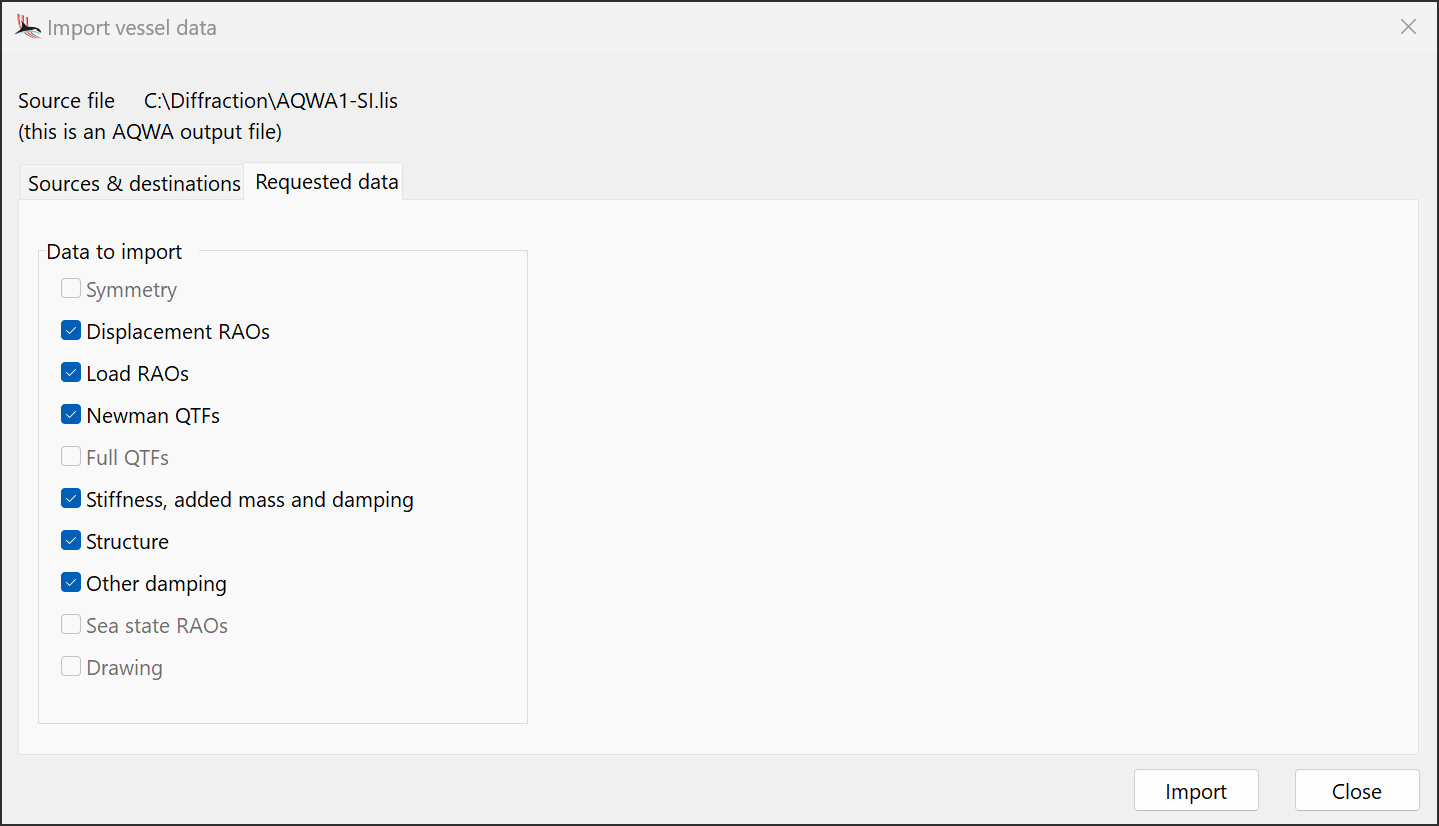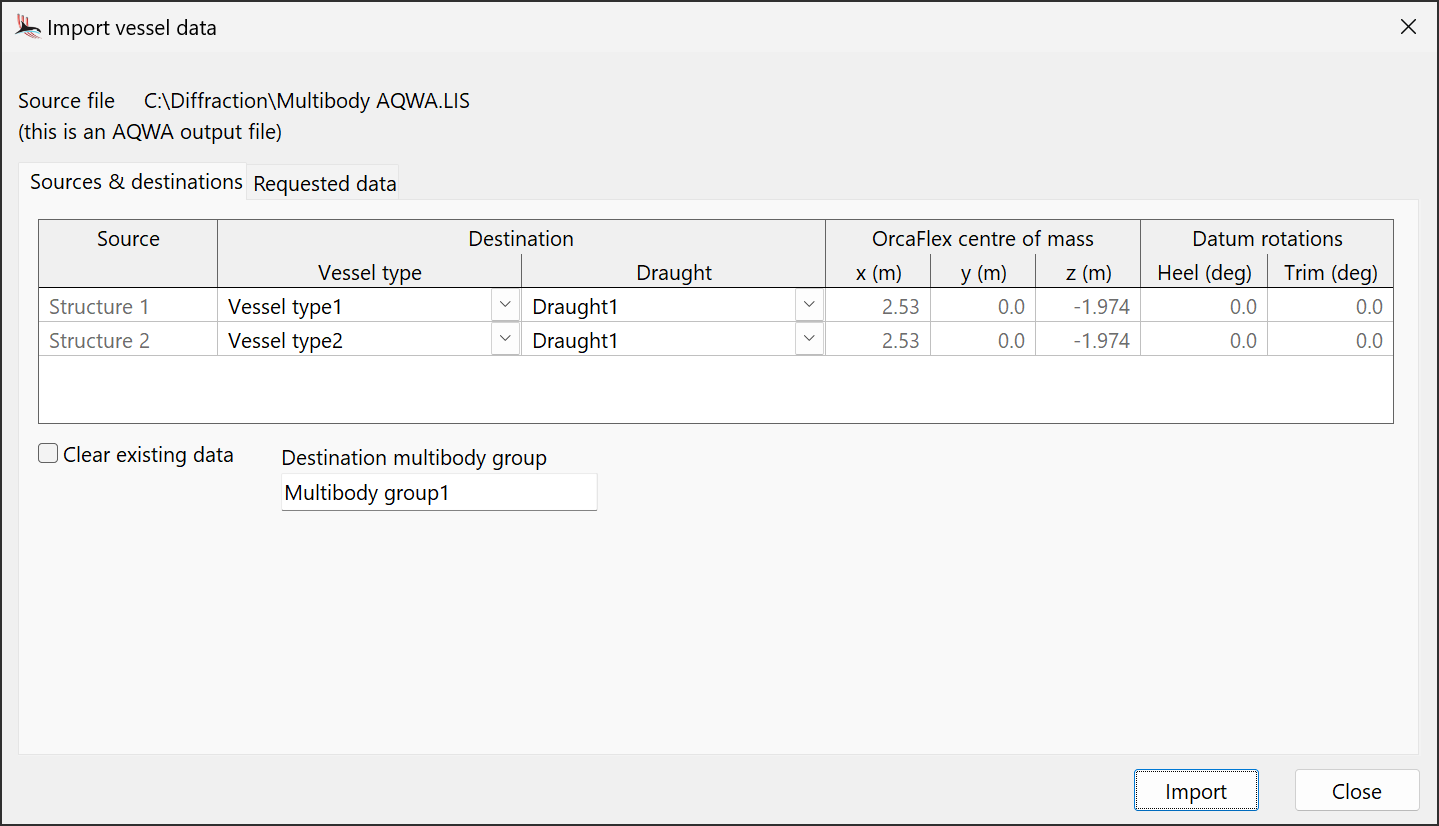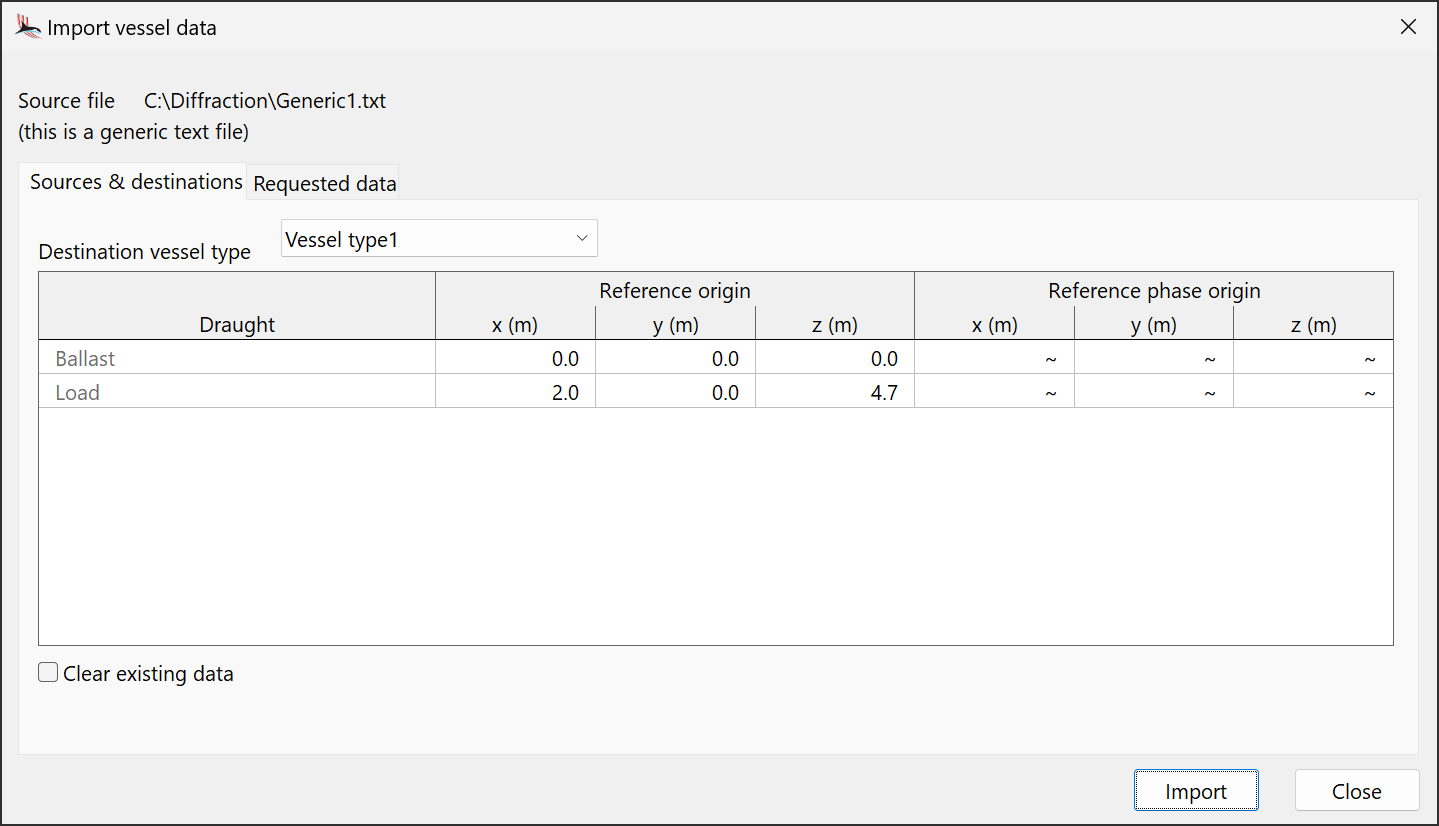
|
Importing hydrodynamic data |

|
Importing hydrodynamic data |
The import button on the vessel types form enables the import of data, in the form of results from common ship response calculation packages, into OrcaFlex. OrcaFlex can import directly data which have been output by OrcaWave, AQWA and WAMIT. OrcaFlex can also import data from MOSES, Hydrostar/ARIANE and WADAM output files, as well as others, after the addition of some markup text. Some packages (notably Hydrostar and WADAM) can also report their results in WAMIT format, in which case they can be imported easily and directly by OrcaFlex without the requirement for markup text.
In all cases, pressing the import button prompts you to select a file for import. When you do so, OrcaFlex will open the file and analyse its content to determine: what type of file it is (OrcaWave, AQWA, WAMIT, or generic), what bodies/structures it has data for, and what data it contains which OrcaFlex is capable of importing (any or all of: symmetry, displacement RAOs, load RAOs, QTFs, added mass and damping, hydrostatic stiffness, structure, other damping, sea state RAOs, drawing). You will then see the import vessel data form, which is where you can choose the destination vessel types and draughts for the data to be imported and check or set reference origins (see below for OrcaWave/AQWA/WAMIT and for generic text files), and select which data you wish to import from the file:

| Figure: | Selecting data for import |
Data types in this list which are disabled (greyed out) are so because either they are not present in the file or their import from this type of file has not been implemented in OrcaFlex (or both). By default, all data types which are present in the file and eligible for import are selected for import at this point: simply deselect any which you do not wish to import. Having chosen your destination vessel types/draughts, checked or set up origins, and selected the data types you wish to import, click on the import button to begin the actual import procedure. The imported data are converted to match the prevailing vessel type conventions (but see QTF data source conventions below) and scaled to match the units of the OrcaFlex model. The remaining OrcaFlex vessel type data are not typically calculated by diffraction programs, so will need to be obtained from another source. Any OrcaFlex data for which there are no corresponding data in the imported file will not be changed.
Following the import, a messages page will be created, which will indicate whether or not the import was successful (if not, the original vessel type data will be retained) and will list any errors or warnings raised during the process. You should take careful note of these, since they will have an impact on how the imported data have been interpreted by OrcaFlex.
The sources & destinations page has mostly the same form for OrcaWave, AQWA and WAMIT files, with a few small differences. One difference is in the naming of the data sources: AQWA refers to structures and WAMIT to bodies; OrcaWave has bodies that are named by the user.

| Figure: | AQWA/WAMIT sources and destinations |
The table on this page will contain one row for each structure/body in the import file. Usually there will be only one, but OrcaFlex is able to import multibody data where it is given. For each source, you must select a vessel type and draught destination to where the data for that source will be imported: each vessel type/draught combination in the table must be unique. Also given, though not editable here, are the centre of mass and the datum heel and trim angles of the vessel type/draught, as a reminder that these data must be correct before import – this is so that the relation between the OrcaFlex vessel and the OrcaWave/AQWA/WAMIT origins and axes can be determined. These relationships are used during the import process to set the reference origins and mass/inertia matrix appropriately in OrcaFlex.
| Note: | The datum heel and trim angles are not shown when importing an OrcaWave file. These data will be read from the OrcaWave file directly and, if importing stiffness, added mass and damping data, set automatically during the import process. |
For more details on the import procedure, see the specific topics on importing OrcaWave data, importing AQWA data and importing WAMIT data.
Checking the clear existing data check box will remove all existing diffraction data from the relevant destination bodies before importing.
| Note: | The centre of mass and the datum heel and trim angles are never cleared. As discussed above, these are necessary to determine the relationship between the OrcaFlex coordinate system and those in the imported hydrodynamic file. |
If the OrcaWave, AQWA or WAMIT file contains multibody data, then you must also specify a destination multibody group which will contain all the vessel type/draught destinations in the list. This multibody group does not need to exist beforehand: by default, OrcaFlex will create a new one. If you use an already-existing one, it will be emptied before the new data are imported into it. Multibody stiffness and added mass and damping data are imported for the members of the group.
When you import multibody data, the corresponding independent (i.e. non-multibody) data are also assigned as part of the import process. These independent data, on the vessel types form, are hidden for a vessel type/draught in a multibody group, as they are not used by OrcaFlex; if you delete a vessel type/draught from a multibody group, the independent data become visible and may be used. Specifically, these data are the same stiffness and buoyancy data and the diagonal $6{\times}6$ blocks of the whole group added mass and damping matrices.
If the import file contains data for a single body only, then the destination multibody group data will not be visible and no multibody data will be imported.
With the exception of the WAMIT RAO rotation conventions, OrcaFlex is unable to take account of the QTF data source conventions which were originally used by either AQWA or WAMIT to generate the imported QTF data (if any), so you must set these vessel type conventions yourself. The necessary data do not appear to be output by either of these programs; you may need to obtain this information directly from their respective publishers. The QTF data source conventions for OrcaWave are known and will be imported automatically.
We use the term generic text files to refer to output from other diffraction software packages which has been marked up with specific text that enables OrcaFlex to import the data. The following data may be imported from such files:
Multibody data cannot be imported from these files. Hence only a single vessel type may be selected as the destination for these data and, though multiple draughts are allowed, interacting vessel data are not imported. Also, since OrcaFlex cannot determine the origin of vessel data in these files as it can for OrcaWave, AQWA and WAMIT, you must enter at the time of import the reference origins and phase origins, relative to the selected vessel type origin, in OrcaFlex units and with respect to OrcaFlex vessel axes:

| Figure: | Generic sources and destinations |
The values of these reference origins will be assigned to the reference origins for the imported RAO, QTF and added mass and damping data.